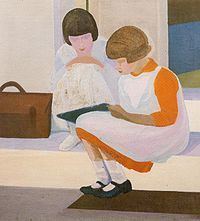Nationality Uruguayan Occupation Painter | Name Petrona Viera Parents Feliciano Viera | |
 | ||
Full Name Petrona Viera Garino Died October 4, 1960, Montevideo, Uruguay | ||
Los artistonautas petrona viera recreo
María Petrona Viera Garino (24 March 1895 – 4 October 1960), commonly known as Petrona Viera, was an Uruguayan painter known for being the first female professional painter in Uruguay and for her participation in the Planismo movement.
Contents

Apuntes petrona viera
Biography
Petrona Viera was born in Montevideo to Carmen Garino and Uruguayan President Feliciano Viera. At the age of two, Viera contracted meningitis, which left her deaf. Her parents hired a French teacher specializing in deaf education, Madeleine Larnaudie, who taught her lip reading and sign language.
Around the age of 20, Viera began to take private painting lessons with the Catalan artist Vicente Puig, but she stopped working with him when he left the country a few years later. In 1922, she began to take lessons from Guillermo Laborde, who influenced her to join the Planismo movement. She began to exhibit her paintings in 1923, and had her first solo exhibition in 1926 at Galería Maveroff. Guillermo Laborde's death in 1940 affected her deeply, and led her to change the direction of her work. After his death, she worked with Guillermo Rodríguez and began producing engravings, watercolors, and ceramics. She continued to paint, but her themes changed, and she began to paint more landscapes and nature scenes than her previous scenes of children's life.
Style and work
Petrona Viera is associated with Planismo, a Uruguayan artistic movement from the turn of the 20th century that was known for its austere lines and bright colors. Her work has many typical features of Planismo, such as clear lines, defined contours, flat structures, and a warm palette with primary and secondary colors. However, her work differs from that of other Planismo artists in that she painted themes of daily life rather than landscapes. Her art often includes scenes of her home, children playing and reading, servants, and her sisters. Later in her career, she shifted her style and painted more landscapes.
